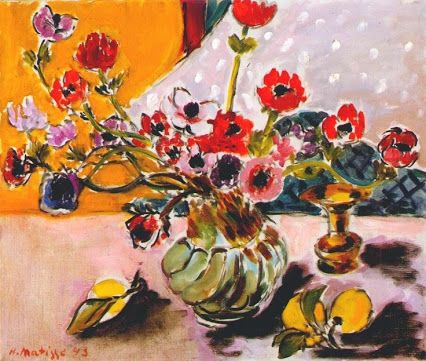Description
The work "Anemones and Chinese Vase" created by Henri Matisse in 1943 masterfully encapsulates the symbiosis between ornamental simplicity and chromatic depth, distinctive characteristics of the artist's final stage. In this painting, Matisse employs a vibrant use of color that becomes the protagonist, even surpassing the depicted figures. The selection of an intense palette with red, blue, and green tones highlights not only the vitality of the anemones but also the delicacy and exoticism of the Chinese vase, both elements that cement the intriguing character of the composition.
Matisse's attentive vision towards ornamental details is evident in the representation of the Chinese vase, whose decorated surfaces display intricate and repetitive motifs that evoke a rich oriental heritage. It is noteworthy how these details do not steal the spotlight from the whole but complement it, establishing a fluid and harmonious dialogue between the flora and the decorative object. This play of visual and cultural relationships is characteristic of Matisse, who often integrated elements from various cultures into his works, thus enriching the visual narrative and offering multiple layers of interpretation.
Likewise, the arrangement of the anemones in their vase does not follow a rigid or structured pattern, reflecting Matisse's approach to a freer and more spontaneous form of visual organization. The flowers, with their delicate petals open towards the viewer, almost seem to move, imbuing the scene with a vitality and freshness that contrasts deeply with the static serenity of the vase. This dialectic between stillness and movement gives the piece an internal dynamic that invites the viewer to a more prolonged and profound contemplation.
The background of the painting, although seemingly simple with its neutral tones, plays a crucial role in highlighting the main figures. The choice of a less prominent background was clearly intentional to emphasize the vivid colors of the vase and flowers, allowing the viewer's eyes to focus without distractions on the core of the work. Through this technique, Matisse demonstrates his genius for balancing elements and keeping attention where he desires.
"Anemones and Chinese Vase" can also be read as a visual alchemy where Matisse continues to explore his relationship with nature and informality. This work, even in its apparent simplicity, is a testament to the artist's technical mastery and his ability to transform everyday scenes into intense and transformative visual experiences. Observing this painting, one cannot help but perceive the symphony of colors and forms that Matisse orchestrates with unparalleled skill, reaffirming his preeminent role in the history of 20th-century art.
In conclusion, Matisse's creation in this late stage of his career not only underscores his constant stylistic evolution but also his unwavering passion for color and form. "Anemones and Chinese Vase" is much more than a floral representation; it is a celebration of Matisse's visual world, a universe in which every element, however humble it may seem, becomes essential, vibrant, and full of meaning.

